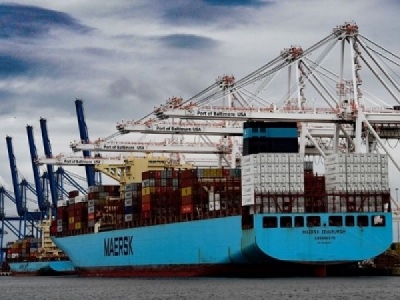
Posted on August 24, 2020
A new record was set at the Helen Delich Bentley Port of Baltimore’s Seagirt Marine Terminal, with 5,536 container moves conducted by longshore workers handling the 13,092 TEU Maersk Edinburgh over three days. It was the largest number of moves for a single ship in the port’s 314-year history, passing the previous record of 5,181 moves set in 2019. The record comes as Baltimore invests in expansion of its port facilities.
“This record container activity is a significant milestone for the Port of Baltimore and a sign that the maritime shipping industry is coming back and fueling Maryland’s economic recovery,” said Governor Larry Hogan. “The container growth at the Port of Baltimore shows the benefits of public-private partnerships in delivering infrastructure more quickly and stretching state and federal dollars by also relieving the state of the long-term infrastructure maintenance costs.”
The Port of Baltimore has been successful in attracting large ships such as the Maersk Edinburgh because of infrastructure investment to accommodate large vessels. The port’s 50-foot berth was built as part of the public-private partnership (P3) between MDOT MPA and Ports America Chesapeake, which operates Seagirt Marine Terminal. In addition to the deeper berth, the port installed four supersized container cranes and made investments including $100 million for Maryland roads, bridges and tunnels as part of a 50-year operating agreement with Ports America Chesapeake.
“We’re seeing more containerized cargo coming into the Port of Baltimore because we maximize cooperation with the private sector,” said William P. Doyle, executive director of the Maryland Department of Transportation Maryland Port Administration (MDOT MPA). “The Port of Baltimore thrives on its growing, open-for-business focus to attract partnerships, including e-commerce-related warehousing, distribution and fulfillment centers.”
Work is progressing on a second 50-foot berth that will allow the port to accommodate two large ships at the same time. That berth, and four additional supersized cranes, are expected to be operational by summer 2021. The $116.4 million investment includes $103 million from Ports America, $7.8 million from the state and $6.6 million in federal funding.
The growing container business at the port has also spurred the planned expansion project for the Howard Street Tunnel in Baltimore. That project will allow double-stacked rail cars to move cargo quicker and with more efficiency from the port, and is also benefiting from a public-private investment from the state, CSX and others.
Last year the Port of Baltimore handled a record 43.6 million tons of cargo, including more than 11 million tons of general cargo. The Port of Baltimore ranks first among the nation’s ports for volume of autos and light trucks, roll on/roll off heavy farm and construction machinery, and imported gypsum. It ranks eleventh among major U.S. ports for cargo handled and ninth nationally for total cargo value.
Source: The Maritime Executive





